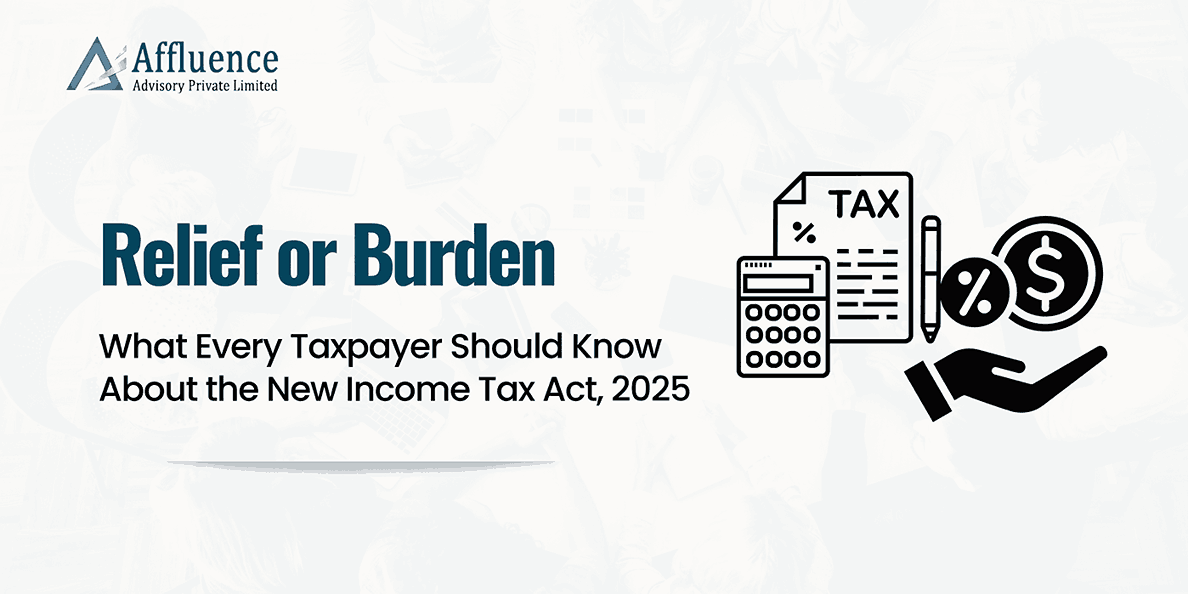The Income Tax Act, 1961, regulates income taxation in India. Existing for over six decades, the act has been regulating various phases of the Indian economy. Over the years, the government has improved its efficiency by issuing multiple amendments and changes to the Finance Act annually, among other measures.
Due to this, the act became bulky, creating complications and thus causing a disconnection between the law and the current reality.
In light of this, the Income Tax Bill 2025 was introduced. It received the President’s assent on 21st August 2025. It will be effective from 1st April 2026.
KEY CHANGES IN THE NEW INCOME TAX ACT
With the new income tax act, the government aims to simplify the legal language, thereby improving readability and removing any redundancy.
The key changes in the new income tax are as follows-
1. Structural Changes
- Clarity- The new income tax act aspires to simplify the legal language of the act. With this, the interpretation of the law will be easier, thus avoiding confusion. This will also reduce the dependency of taxpayers on tax professionals for the return filing process.
- Concept of Tax Year- The new income tax act eliminates the confusion between the previous year and the assessment year by replacing them with a Tax Year (1st April to 31st March). With this, users can easily understand the taxation period and report income accordingly.
- Organised Provisions- Even though the new Income Tax Act will retain most provisions of the old Income Tax Act, it will significantly reduce the number of sections from 819 to 536.
- Sequential numbering and consolidation- To improve referencing, all sections will be numbered sequentially. Also, sections regarding similar topics will stay under a single section; for example, all TDS-related sections will be grouped under Section 393, which were earlier under Section 192 to Section 194.T.
2. Changes in the administrative and reporting
- Virtual Digital Assets Taxation- The new income tax act clears all the confusion around the taxation of virtual digital assets (VDAs). It expands the definition to cover cryptocurrencies, NFTs or similar technologies and will be taxed at a flat 30% plus 4% cess for both short-term and long-term gains. No deduction other than the cost of acquisition is allowed.
VDAs are also now included in undisclosed income. If the tax authorities discover undisclosed income from VDAs during investigations, strict penalties and litigation may apply.
- Digital Data Scrutiny- Tax authorities will have enhanced powers to access various digital assets, including but not limited to emails, cloud storage, social media, and trading accounts.
- Rationalisation of TDS/TCS- The act removes Section 206AB and 206CCA, which charged a higher TDS/TCS for non-filers. This will also reduce the compliance burden on businesses to verify the return filing status of payees.
- Ease of updated return and claiming of Refunds- The new act provides an extension in the filing time limit for filing an Updated Return from 24 months to 48 months, thereby providing a longer time space to rectify any errors or omissions and claim refunds for the taxes paid previously.
- Elimination of the Notional Rent Tax- The New Income Tax Act provides relief to house property owners by eliminating Notional Rent. With this provision, the NAV of properties for up to two housing properties is deemed as nil. Previously, in the Income Tax Act, 1961, if a taxpayer owned more than one house property, the second and subsequent properties were deemed to be rented and hence taxed accordingly.
This new provision directly benefits families who often have a home in the town where they work, and another house property in their hometowns. This also removes the unfairness which the old act has been causing, i.e, income tax on an income which the taxpayer has actually never earned. Also, this provision is limited to two house properties only. For taxpayers like property investors who own multiple properties, they can claim NIL NAV for up to two properties.
- Changes in Tax Liability
Tax Slabs
Individual Taxpayer – New Slabs and higher Deductions
|
Tax Slabs (New Regime) – FY 26-27 |
Tax Slabs (Old Regime)- FY 26-27 |
||
|
INCOME |
TAX RATES |
INCOME |
TAX RATES |
|
Up to INR 4 lacs |
0% |
Up to INR 2.5 lacs |
0% |
|
INR 4 lacs to 8 lacs |
5% |
INR 2.5 lacs to 5 lacs |
5% |
|
INR 8 lacs to 10 lacs |
10% |
INR 5 lacs to 10 lacs |
20% |
|
INR 12 lacs to 16 lacs |
15% |
Above 10 Lacs |
30% |
|
INR 16 lacs to 20 lacs |
20% |
|
|
|
INR 20 lacs to 24 lacs |
25% |
||
|
Above 24 Lacs |
30% |
||
Higher Standard deduction – Standard Deduction for Salaried individuals increased under the new tax regime from INR 50,0000 to INR 75,000
Increase in Rebate under section 87A
The rebate under section 87A of the Income Tax has increased from INR 25,000 to INR 60,000 in the new tax regime. Hence, a salaried person with a Gross Salary of INR 12,75,000 after standard deduction of INR 75,000 will make their taxable income 12,00,000 and hence eligible for a full tax rebate under the new tax regime. However, tax on special rate income, like capital gains, winnings, etc, is excluded from the rebate in the new tax regime.
How Will This Affect Various Taxpayers?
In the new Income Tax Act 2025, the New Tax Regime will be a default option. However, the taxpayers can still opt for the Old Tax Regime.
- Salaried Individuals
With broader slab rates, salaried taxpayers can have a gross salary up to INR 12,75,000 and still pay zero taxes. However, if they opt for this, it will disallow most exemptions and deductions like HRA, specified investments under section 80C, mediclaim under section 80D, LTA, etc. Still, middle-income salaried taxpayers can enjoy maximum benefits.
- Proprietary Business / Professionals
Proprietary businesses and professionals are also covered under the new tax regime. Compliances will become easier, but those who have structured their income via deductions/exemptions earlier may face slightly higher tax liability, as the option for opting out of the old/new tax regime is limited for taxpayers having Income from business/profession.
- Corporations
The new income tax act keeps corporate taxation unchanged. The act will focus on digital compliance and scrutiny. The act will require businesses with receipts greater than 50 crore to accept payment via prescribed electronic modes (eg UPI, RuPay, etc). Non-compliance with providing mandated digital modes may lead to penalties & scrutiny.
- NRIs
The new income tax will mostly stay unchanged for NRIs. Also, NRIs cannot claim a rebate under section 87A, as it is allowed only to Resident Individuals.
Final Word
Conclusively, the New Income Tax Act, 2025, is a leap towards simplicity. The act aims not to trash the previous law but rather to simplify and modernise it according to the current economic status of the country. As the act is all set to be enacted on 1st April 2026, it will be a historic moment for India’s tax landscape.
While taxpayers can choose between the old tax regime and the new tax regime, the goal is to make the return filing process easier and provide more transparency. At the crux of it, every taxpayer should keep in mind that this act is a commitment towards an efficient, clear, digital, hassle-free system, thereby making it taxpayer-friendly.
Disclaimer:This article provides general information existing at the time of preparation and we take no responsibility to update it with the subsequent changes in the law. The article is intended as a news update and Affluence Advisory neither assumes nor accepts any responsibility for any loss arising to any person acting or refraining from acting as a result of any material contained in this article. It is recommended that professional advice be taken based on specific facts and circumstances. This article does not substitute the need to refer to the original pronouncement.
CLICK HERE DOWNLOAD PDF








